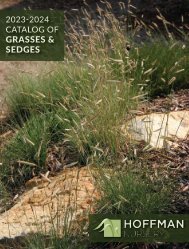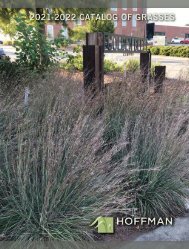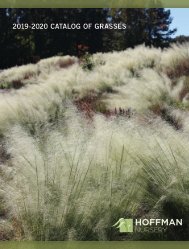2022-2023 Hoffman Nursery Catalog of Grasses & Sedges
You also want an ePaper? Increase the reach of your titles
YUMPU automatically turns print PDFs into web optimized ePapers that Google loves.
PLANTS FOR GREEN INFRASTRUCTURE<br />
Green infrastructure (GI) uses plants, soils, and natural processes to manage water<br />
and add ecological function to new and existing development. These two<br />
pages give an overview <strong>of</strong> common GI features that include plants. Pages 12-14<br />
suggest grasses, sedges, and rushes that should perform well in the growing environments<br />
<strong>of</strong> these features. Many stormwater guidelines recommend native<br />
plants, so we focus mainly on North American selections. Well-adapted, introduced<br />
plants can also be good choices, and they are marked by an asterisk (*).<br />
Other plants we grow could also work, but these are our top suggestions.<br />
BIORETENTION &<br />
RAIN GARDENS<br />
BIOSWALES &<br />
VEGETATED SWALES<br />
EROSION CONTROL<br />
Erosion Control plants keep soil in<br />
place and improve water quality by<br />
keeping sediment and pollutants out <strong>of</strong><br />
waterways.<br />
• The branching, fibrous root systems<br />
<strong>of</strong> grasses and sedges stabilize soil,<br />
especially on banks and slopes.<br />
• These plants keep their habit when<br />
dormant, continuing to slow water<br />
even when not growing.<br />
• They need little maintenance and<br />
are quick to establish, which can be<br />
critical on steep inclines or embankments.<br />
GREEN ROOFS<br />
Green Ro<strong>of</strong>s help manage stormwater,<br />
reduce energy consumption, provide<br />
wildlife habitat, and increase ro<strong>of</strong><br />
lifespan. Green ro<strong>of</strong> systems typically<br />
have low fertility and shallow soil conditions.<br />
• Plants must be heat and drought<br />
tolerant, provide consistent coverage,<br />
use nutrients efficiently, and<br />
have non-aggressive root growth.<br />
• Green ro<strong>of</strong>s in regions with hot,<br />
humid summers can receive heavy<br />
rainfall and have extended periods <strong>of</strong><br />
saturation. Plants for these regions<br />
should be selected for both high water<br />
use and drought tolerance.<br />
Bioretention & Rain Gardens are<br />
vegetated depressions in the ground.<br />
They provide storage, evapotranspiration,<br />
and treatment <strong>of</strong> stormwater<br />
run<strong>of</strong>f. They drain within 24-48 hours<br />
and dry out when rain is sparse.<br />
• Plants must be able to handle both<br />
wet and dry conditions and tolerate<br />
pollutants from surrounding land<br />
use.<br />
• Bioretention cells are <strong>of</strong>ten divided<br />
into zones based on wetness. Plants<br />
should fit the appropriate zone:<br />
lowest – standing water and fluctuating<br />
water levels; middle – mainly<br />
fl u c t u a ti n g w ate r l eve l s; u p p e r –<br />
usually drier, and upland species can<br />
do well.<br />
Bioswales & Vegetated Swales are<br />
gently sloping channels planted heavily<br />
with a variety <strong>of</strong> species. They<br />
s l ow w ate r fl ow, fi l te r o u t t r a s h a n d<br />
pollutants, and allow for infiltration<br />
and evapotranspiration.<br />
• Plants must have strong, extensive<br />
root systems and establish quickly.<br />
• Plants for the bottom <strong>of</strong> bioswales<br />
need to be able to handle fluctuating<br />
conditions between wet and<br />
dry.<br />
• Plants for the upper slopes need to<br />
be tolerant <strong>of</strong> wet conditions, but<br />
also must be able to tolerate consistent<br />
dryness between rain events.<br />
LAWN ALTERNATIVES<br />
Lawn Alternatives create a low ground<br />
cover that does not need regular<br />
mowing or fertilizing. Compared to<br />
turfgrass, they reduce resource use<br />
and maintenance burden.<br />
• Many handle dry conditions once<br />
established and do not need supplemental<br />
irrigation.<br />
• Can tolerate mowing two-three<br />
times a season if desired, but only<br />
need cutting back once a year in late<br />
winter before new growth appears.<br />
Mow high at 3-8”.<br />
• Most appropriate for areas with no<br />
or low foot traffic.<br />
MEADOW & PRAIRIE<br />
PLANTINGS<br />
Meadow & Prairie Plantings reduce<br />
stormwater run<strong>of</strong>f, add green spaces<br />
i n u r b a n a r e a s , a n d s u p p o r t a r i c h<br />
variety <strong>of</strong> wildlife. Replace a stretch<br />
<strong>of</strong> turfgrass with a visually compelling<br />
meadow or prairie planting.<br />
• Plantings are usually open communities<br />
<strong>of</strong> grasses and wildflowers, with<br />
few trees.<br />
• <strong>Grasses</strong> and sedges for these plantings<br />
cover a wide variety <strong>of</strong> conditions.<br />
Most do well in low-fertility<br />
soils, thrive in full sun, and are<br />
drought tolerant. For wet meadows,<br />
check individual plant listings.<br />
10<br />
11








